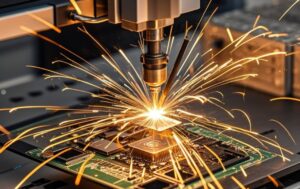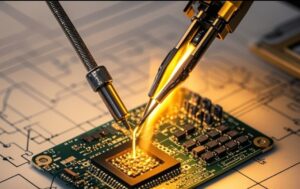目录
ToggleIntroduction to Reflow Soldering Reflow soldering is a process used in electronics manufacturing to attach surface-mount components to a printed circuit board (PCB). The solder paste, applied earlier, melts and solidifies to create strong electrical connections when exposed to the correct temperature profile. Proper temperature setting, often referred to as “solder reflow temperature,” is crucial for ensuring the reliability and performance of the final electronic assembly.

Key Factors Influencing Solder Reflow Temperature Settings
Solder Paste Composition: Different solder pastes have varying melting points and thermal profiles. The composition of the solder paste, including the type of flux and the ratio of alloy components, directly influences the solder reflow temperature settings required for reflow.
Component Sensitivity: Some electronic components are more sensitive to heat than others. Components like plastic connectors and capacitors can be damaged by excessive heat, requiring careful temperature management.
PCB Material: The thermal properties of the PCB material, such as its heat capacity and thermal conductivity, affect how heat is distributed during the reflow process. Materials with higher thermal mass require longer heating times or higher solder reflow temperatures.
Methods for Setting Reflow Soldering Temperatures
Thermal Profiling: Creating a thermal profile involves mapping out the temperature changes over time that the PCB will undergo in the reflow oven. A standard thermal profile includes preheating, soaking, reflow, and cooling stages. The profile ensures that all parts of the PCB reach the necessary solder reflow temperature for proper soldering.
Oven Programming: Modern reflow ovens are equipped with programmable settings that allow precise control over the temperature at different stages of the process. Operators can adjust these settings based on the specific requirements of the solder paste and components being used.
Zone Control: Reflow ovens often have multiple heating zones, each with independent temperature control. This allows for gradual and controlled heating, minimizing the risk of thermal shock and ensuring even temperature distribution across the PCB.

Common Challenges and Solutions in Reflow Soldering
Solder Defects: Issues such as solder balling, bridging, and tombstoning can occur if the solder reflow temperature profile is not properly set. These defects can be mitigated by fine-tuning the thermal profile and ensuring uniform heat distribution.
Thermal Damage: Overheating can damage sensitive components and the PCB itself. Implementing precise thermal profiling and using appropriate cooling methods can help prevent thermal damage.
Inconsistent Results: Variations in the thermal properties of different batches of PCBs or components can lead to inconsistent reflow results. Regular calibration of the reflow oven and consistent monitoring of the process can improve reliability.
Future Trends in Reflow Soldering Technology Advancements in reflow soldering technology are focusing on improving efficiency and accuracy. Developments include the integration of advanced sensors and artificial intelligence (AI) for real-time monitoring and adjustment of solder reflow temperature profiles. These technologies can detect anomalies and optimize settings on-the-fly, ensuring consistent and high-quality results. Additionally, eco-friendly practices, such as the use of lead-free solder and energy-efficient ovens, are becoming more prevalent, reducing the environmental impact of the manufacturing process.
By addressing these factors and methods, this content aims to provide a professional, comprehensive, and diverse approach to solving operational problems related to solder reflow temperature settings. Insights from industry professionals emphasize the practical applications and future directions of reflow soldering technology, highlighting its significance in modern electronics manufacturing.
0